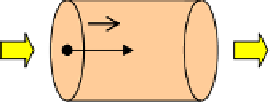Environmental Engineering Reference
In-Depth Information
9.3.
Modeling water transfer in stone
Up to now, water absorption and retention mechanisms in stone that have been
introduced can all be gathered under the general notion of “capillarity”. In this
section we will address how that water can move inside stone under the influence of
capillary forces or, more precisely, when water content or suction differences exist
in the medium.
9.3.1.
Darcy's law of permeability
1
water
2
water
P
P
Q
u
Figure 9.7.
Schematics of water flow through a cylindrical column
of length l and section s filled with saturated porous medium
In the middle of the 19th century, Henri Darcy tried to understand how water
crosses a porous medium
8
. Studying the flow of water across a sand column, he
showed that there is a linear relationship between the water flow
Q
[m
3
.s
-1
] that
crosses the column and the pressure
P
w
applied to its top. Taking the schematics of
Figure 9.7 and “modern” interpretation, with either water pressure
P
water
or capillary
pressure
P
c
as driving variables, this can be written:
2
1
k
P
−
P
k
k
water
water
Q
=
−
s
u
=
−
s
∇
P
=
s
∇
P
[9.18]
water
c
η
l
η
η
where η is the water's
dynamic
viscosity
(≈0.001 Pa.s at 20°C) and
k
a parameter
that measures the capability of the medium to let water through: its
permeability
. ∇
denotes the
gradient
operator
9
.
8 Henri Darcy,
Les Fontaines Publiques de la Ville de Dijon
, Paris, 1856.
9 For the sake of simplicity here, the gradient of a variable is reduced to its variation per unit
length in only one direction. Of course, this notion is more general: the gradient operator ∇ is
applicable in three dimensions for any continuous function in this space and the result is a
vector of the same dimension. Equations presented in this section, however, can be easily
generalized, redefining the different transfer coefficients as
tensors.








